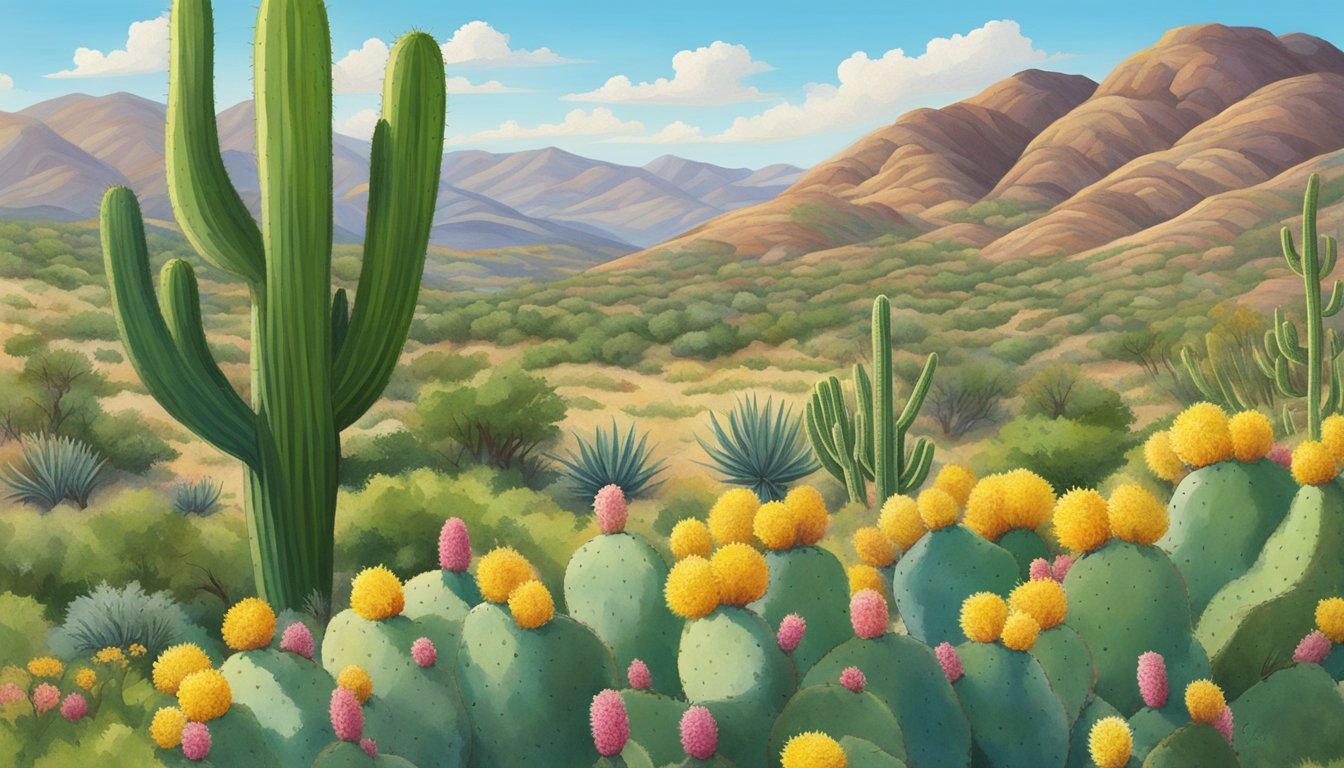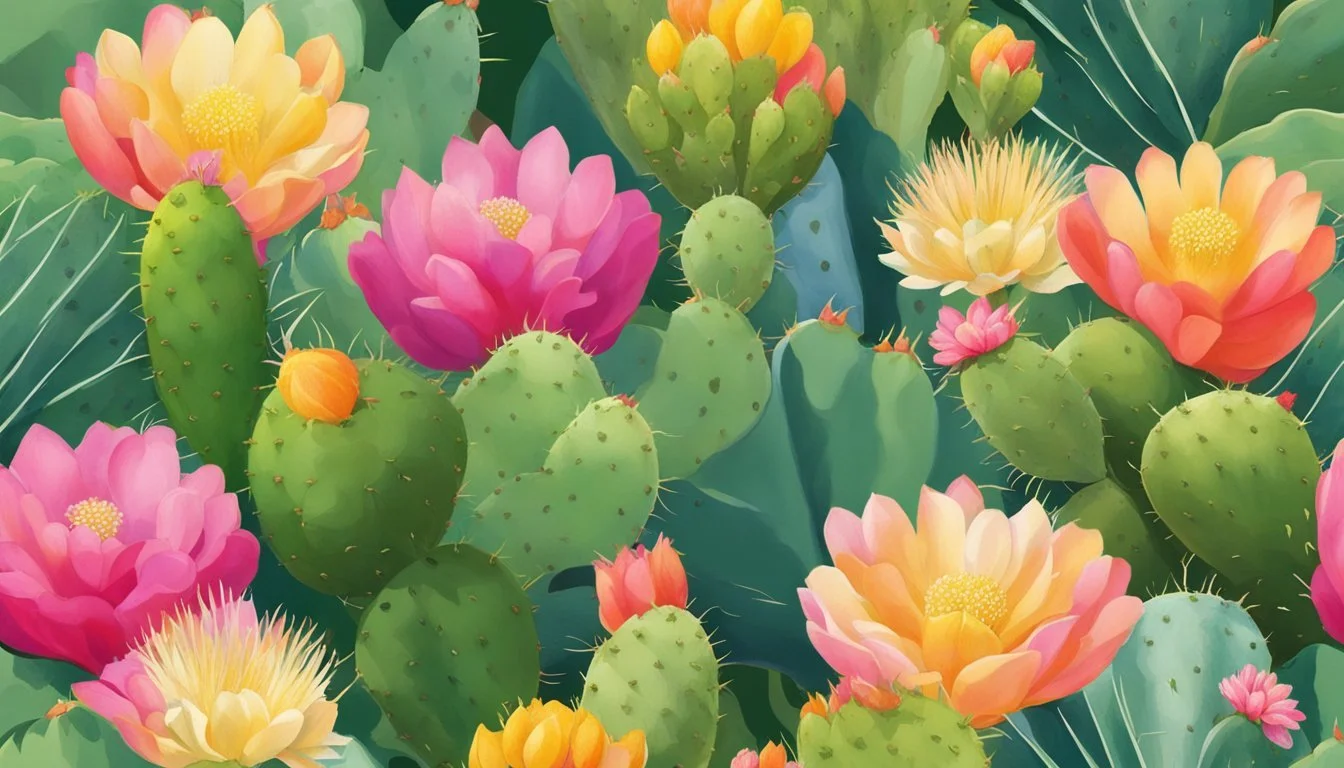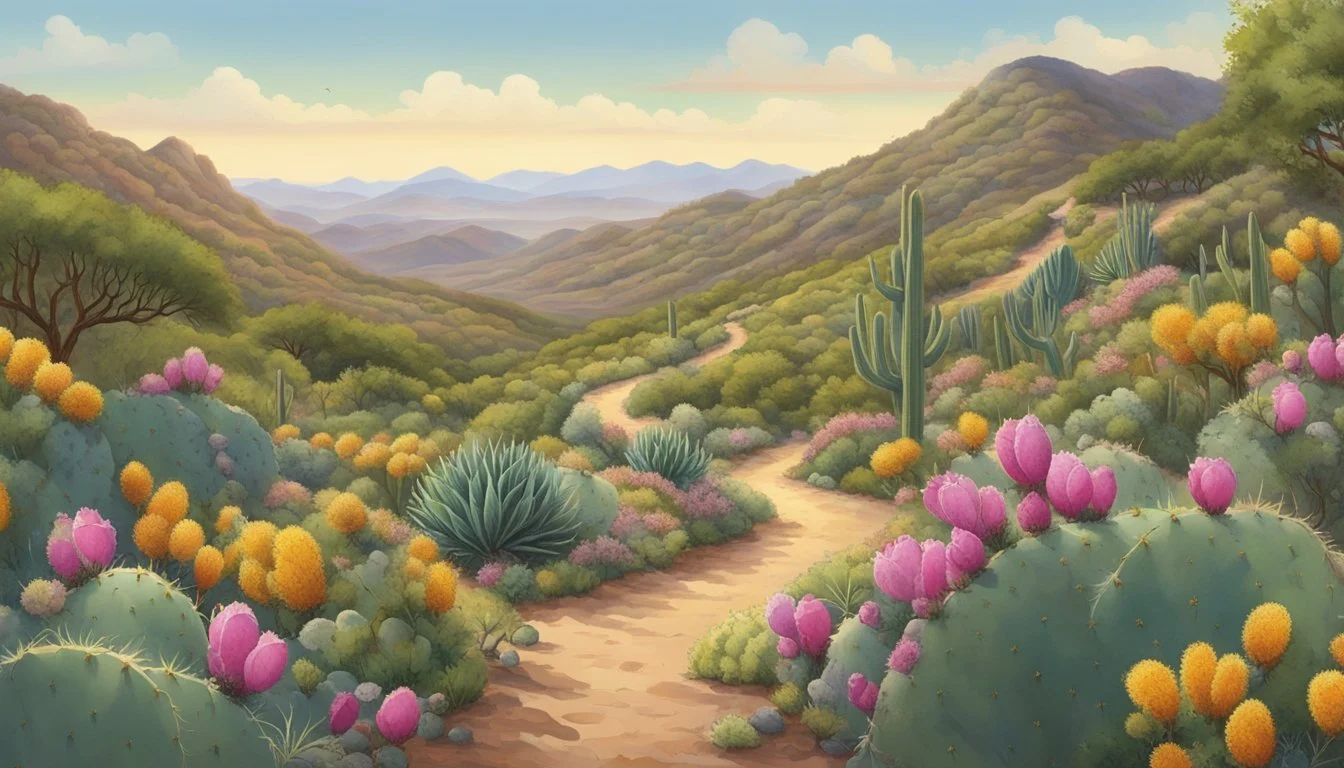Hill Country Native Edible Plants
A Guide to Sustainable Foraging
The Texas Hill Country boasts a diverse range of native edible plants that can be a delight for foragers and nature enthusiasts alike. From the hardy Turk’s Cap with its spiral-patterned flowers and cucumber-apple flavored berries, to the wild dewberry that offers a familiar taste similar to blackberries, the region is abundant with natural food sources.
For those interested in sustainable foraging, understanding the edible flora of Central Texas can enrich both your culinary experiences and your connection to nature. Plants like Briar or Smilax bona-nox, despite their thorny appearance, provide smooth, edible shoots and leaves, illustrating the surprising bounty available in this rugged landscape.
Hill Country Natives have developed robust plants ideal for the local conditions, focusing on species that thrive despite the area's challenging environment. As you explore these native edibles, you'll discover not only their nutritional benefits but also their unique flavors and resilience, making your foraging journey both educational and fulfilling.
Understanding the Texas Hill Country Ecosystem
The Texas Hill Country showcases a diverse and unique ecosystem characterized by its native plants, varied habitats, and the wildlife species it supports. Understanding these elements is imperative to grasp the intricate balance of life in this region.
Significance of Native Plants
Native plants in the Texas Hill Country are vital for maintaining the ecosystem's health. These plants have adapted to the local climate and soil conditions over centuries. Agarita, for instance, produces berries that offer a food source for both humans and animals. The Prickly Pear Cactus, another native species, thrives in the arid landscape and provides edible fruit and pads. These plants reduce soil erosion, stabilize the landscape, and require less water than non-native species.
Common Texas Hill Country Habitats
The Texas Hill Country features a variety of habitats such as grasslands, woodlands, and arid regions. The grasslands support species like Little Bluestem and Indian Grass, which are well-suited for grazing wildlife. Woodlands harbor Oaks and Junipers, providing shelter and food for numerous birds and mammals. Arid regions are home to hardy plants like the Prickly Pear Cactus, which can survive with minimal water. These distinct habitats contribute to the rich biodiversity of the area.
Wildlife and Pollinator Attraction
The diverse flora of the Hill Country attracts a multitude of wildlife, including vital pollinators like bees and butterflies. Bees are crucial for pollinating native plants, ensuring the production of fruits and seeds. Butterflies, like the Monarch, rely on native milkweeds for their lifecycle. Plants such as the Almond Verbena, known for its strong fragrance, draw these pollinators in, supporting the reproductive cycles of both plants and insects. This interaction between flora and fauna maintains the ecological balance.
Edible Native Trees and Shrubs
Hill Country is home to a variety of native trees and shrubs that provide edible fruits and nuts. This selection includes species like the Mexican Plum, Texas Persimmon, agarita, and pecan trees, each contributing to the unique culinary landscape of the region.
Prunus Mexicana and Other Plum Species
Prunus Mexicana, commonly known as Mexican Plum, produces small, sweet-tart plums that are ideal for jams, jellies, and fresh eating.
These trees bloom early and are quite hardy, thriving even in challenging conditions. Other plum species in the Hill Country include wild cherry plums, which similarly offer valuable fruit for culinary uses. These plums attract wildlife and are often found in mixed woodlands.
Texas Persimmon and Black Fruit Trees
Diospyros Texana, or Texas Persimmon, yields small, black fruits that are sweet when fully ripe. These trees flourish in the dry, rocky soils of the region.
The fruits are often used in desserts, preserves, and as a fresh snack. Other notable trees producing black fruits include the Anacua (Ehretia Anacua) and the wild black cherry, which provide both edible and wildlife food sources.
Berry-Producing Shrubs
Key berry-producing shrubs include agarita and dewberry.
Agarita features hardy bushes with bright red berries that are ideal for making jams, pies, and other treats. Dewberries, which resemble blackberries, are most commonly found in thickets and along fencerows. These berries often serve as a gateway for foragers new to native edible plants due to their familiar taste and appearance.
Nut-Bearing Trees
Pecans are the standout nut-bearing trees in the Hill Country, providing not only nuts for snacking but also ingredients for baking and cooking.
Other nut-bearing species include the American hazelnut and, less commonly, the native species of the pawpaw family. These trees offer a mix of dietary staples and seasonal treats, integral to the local diet and culinary traditions.
Foraging and Identification
Foraging native edible plants in the Hill Country requires a blend of ethical practices, accurate identification, and careful harvesting. Understanding these elements ensures sustainability and safety.
Best Practices for Ethical Foraging
Respect Nature: Only take what you need to leave enough for wildlife and plant regeneration. Over-harvesting can deplete plant populations.
Follow Regulations: Always check local rules and guidelines. Some areas may have restrictions on foraging to protect endangered species or habitats.
Minimize Impact: Stick to established trails and avoid trampling vegetation. When picking plants, use tools to minimize damage to roots and the surrounding ecosystem.
Identification Techniques
Use Reliable Sources: Invest in field guides or use trusted websites and apps that offer clear images and descriptions.
Observe Key Features: Look at leaf shape, flower color, berry type, and growth patterns. For example, Turk's Cap has spiral red or pink flowers and edible red berries.
Verify with Experts: Join foraging groups or workshops. Experienced foragers can help confirm plant identities, increasing your confidence and safety in the field.
Harvesting and Storage Tips
Timing: Harvest plants when they are most nutritious. For example, berries often have the best flavor and nutrition at the end of summer.
Methods: Use clean, sharp tools for cutting stems or digging roots. Avoid pulling plants out by hand to prevent damage.
Storage: Store freshly harvested plants in breathable containers and keep them cool. For longer preservation, consider drying, freezing, or pickling.
Following these practices will help ensure a rewarding and responsible foraging experience in the Hill Country.
Cultivating Native Edible Plants
Cultivating native edible plants in the Hill Country requires thoughtful garden design, proper soil and water management, and consistent propagation and maintenance practices. These elements ensure robust growth and resilience against local conditions.
Garden Design for Edible Natives
Designing a garden for native edible plants involves considering local soils, rainfall, and sunlight availability. Hill Country soils are often rocky, necessitating raised beds or amended soil for better root development.
Key Points:
Select plants suited for full sun or part shade.
Group plants with similar water needs.
Incorporate organic matter to improve soil fertility and moisture retention.
Use rocks strategically to create microhabitats and stabilize the soil. This design mimics natural conditions, helping plants thrive.
Soil and Water Management
Native plants generally adapt to the region's unique soil and water conditions. Soil preparation is crucial; enrich it with organic matter to enhance nutrient content and moisture retention. Testing soil pH can also be beneficial for specific plant needs.
Key Points:
Utilize drought-tolerant species to reduce water usage.
Implement mulching to retain moisture and reduce evaporation.
Water deeply but infrequently to encourage deep roots.
Managing water efficiently ensures plants survive dry periods common in the Hill Country.
Propagation and Maintenance
Propagation of native edible plants can be performed through seeds or cuttings, reflecting the best rooting systems available. Regular maintenance focuses on weeding, pruning, and monitoring for pests.
Key Points:
Use locally sourced seeds for better adaptability.
Trim plants to promote airflow and reduce disease risk.
Monitor for local insects and apply eco-friendly treatments.
Maintaining a balance in your garden helps native edible plants continue to thrive and produce. Properly timed pruning and regular inspections are essential for long-term garden health.
Health Benefits and Medicinal Uses
Each native plant in the Texas Hill Country offers unique health benefits and traditional medicinal uses. Exploring these plants can reveal valuable insights into their nutritional content and potential applications in both historical and modern contexts.
Edible Plant Parts and Their Nutrients
Many native plants have parts that are not only edible but rich in essential nutrients. For example, Smilax bona-nox (also known as briar) produces tender shoots and leaves high in vitamins and minerals.
Henbit (Lamium amplexicaule) is another example, offering leaves and flowers rich in iron and antioxidants. These greens can be incorporated into salads or cooked dishes, providing a nutrient boost.
Moreover, agaritas yield berries full of vitamins C and A, beneficial for immune support and overall health.
Traditional Medicinal Practices
Native Americans have long recognized the medicinal value of these plants.
Agarita has been traditionally used to relieve nausea and aid digestion by chewing its leaves.
Henbit was often utilized to treat respiratory ailments and boost overall wellness.
Smilax bona-nox shoots and leaves were consumed for their reputed anti-inflammatory properties.
These traditional practices highlight the importance of native plants in natural medicine and their role in local heritage.
Modern Applications of Native Edibles
Today, these plants continue to hold medicinal relevance.
Henbit is increasingly recognized for its potential health benefits, often being dried and used in teas to soothe sore throats.
Agarita berries are made into syrups and tinctures, valued for their antioxidant properties.
Smilax bona-nox finds its way into modern culinary recipes, becoming a sought-after ingredient in gourmet salads and herbal teas.
These applications underscore the enduring value of native Hill Country plants in contemporary health and culinary practices.
Culinary Applications
Native plants in the Hill Country of Texas provide a wealth of culinary opportunities, from using fruits and berries in a variety of dishes to incorporating unique herbs and spices into everyday cooking.
Cooking with Native Fruits and Berries
Texas Hill Country boasts numerous native fruits and berries with distinctive flavors. Turk's Cap produces red berries, which taste like a mix of cucumber and apples. These berries can be used in jams, salads, or even as a refreshing snack.
Wild grapes and agarita berries are also prominent. Agarita berries possess a tart flavor, ideal for jams and sauces. Wild grapes, often used for making wine, enhance recipes ranging from sauces to desserts. The versatility of these fruits makes them an excellent addition to the kitchen.
Herbs and Spices from the Hill Country
The Hill Country is rich with herbs that double as culinary delights and medicinal plants. Sassafras leaves can be dried and made into gumbo file powder, an essential spice in Creole cooking. The leaves of the wild briar, or Smilax bona-nox, offer tender greens that can be sautéed or added to soups.
Yaupon Holly, North America's only native caffeine-producing plant, provides leaves that can be dried to make tea. This hardy herb withstands tough weather conditions and deer, proving its resilience alongside its utility.
Native Plants in Beverages
Indigenous plants also play a role in regional beverages. The Yaupon Holly is particularly celebrated for its caffeine-rich leaves, which create a tea similar to yerba mate.
Additionally, the prickly pear cactus offers juicy fruits, known as tunas, that can be turned into refreshing juices or cocktails. The juice adds a colorful and unique taste to any drink recipe.
Sassafras root, traditionally used to make root beer, provides a distinct and aromatic flavor. These native plants not only contribute to flavorful dishes but also enhance beverages with their unique characteristics and heritage.
Creating a Hill Country Native Edible Landscape
Creating a Hill Country native edible landscape involves selecting plants that provide both beauty and sustenance, implementing strategies to attract local wildlife, and practicing sustainable gardening methods. Focus on native species to promote a resilient and thriving ecosystem.
Selecting Plants for Aesthetic Value
Choosing the right plants enhances the visual appeal of your landscape while offering edible benefits. Prickly Pear Cactus is ideal for arid areas, providing attractive pads and edible fruits.
Agarita bushes feature vibrant red berries and spiky leaves, adding texture and color.
Incorporate Figs for their lush foliage and nutritious fruits.
Native plants like these require minimal maintenance and blend seamlessly into the natural beauty of Hill Country.
Wildlife-Friendly Garden Practices
To create a wildlife-friendly garden, integrate plants that offer food and shelter. Agarita and Prickly Pear Cactus provide berries and pads that attract birds and small animals.
Establish a diverse plant palette to support various wildlife species.
Avoid pesticides and chemical fertilizers; opt for organic options to maintain a healthy ecosystem.
Install water features such as birdbaths or small ponds to attract birds and beneficial insects, promoting a balanced environment.
Sustainable Landscaping Tips
Sustainable landscaping ensures your garden supports the environment long-term. Mulch using wood chips around trees and plants to retain moisture and control weeds.
Select drought-tolerant species like Prickly Pear Cactus to conserve water.
Use organic compost to enrich soil health naturally.
Create a watering saucer around each plant to direct water to the roots effectively.
Prioritize native species, such as those offered by Hill Country Natives, to maintain harmony with the local ecosystem.
These practices contribute to a thriving, beautiful, and eco-friendly edible landscape.
Conservation and Sustainability
Hill Country native edible plants play a significant role in preserving the local ecosystem, promoting biodiversity, and supporting sustainable practices. Protecting these plants through sustainable harvesting methods is essential to maintaining their populations for future generations.
Role of Native Plants in Conservation
Native plants are crucial in maintaining the ecological balance of Hill Country. They are well-adapted to the local environment, which makes them resilient against pests and diseases. By acting as natural barriers, these plants help to stabilize soil and prevent erosion. Native plants also support local wildlife by providing food and habitat, which helps sustain the area's biodiversity.
Additionally, native plants require less water and fewer chemical inputs than non-native species, aiding in resource conservation. This not only promotes healthier soil and cleaner water but also reduces the human environmental footprint.
Sustainable Harvesting Methods
Practicing sustainable harvesting methods ensures that native edible plants remain abundant. One approach is to harvest plants in a manner that allows them to regenerate. For instance, when gathering berries or seeds, leaving some behind ensures that the plants can continue to reproduce.
Rotational harvesting, where different areas are harvested at different times, helps to avoid overexploitation of any single population. This practice helps in conservation by allowing ecosystems time to recover.
Using minimal-impact techniques, such as handpicking and avoiding mechanical harvesting, protects the habitat from damage. Educating local communities about sustainable harvesting is vital for the continual thriving of these native plants.
Protecting Hill Country Biodiversity
Biodiversity in the Hill Country is enhanced by protecting native edible plants. Efforts to conserve these plants contribute significantly to the stability of the ecosystem. Biodiversity supports a wide range of species, ensuring a robust and sustainable environment.
Conservation programs can include creating protected areas where native plants can grow without threat from over-harvesting or development. Involving local communities in conservation efforts by promoting awareness and education helps to foster a collective responsibility toward protecting these natural resources.
Monitoring and research are also key components, as they provide data essential for making informed decisions and implementing effective conservation strategies.









